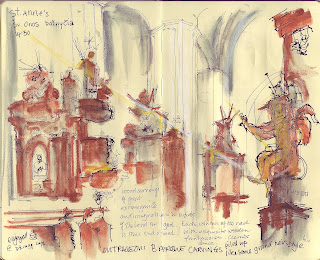I was in Vilnius for a week’s work and was
able to carve out an afternoon to see some of the city’s important churches.
This is capital of Lithuania with some of its city walls intact and people
beetle about in boots and thick coats to keep out the cold (minus 8 most days)
and snow flurries up and down the streets.Vilnius is very much a northern European
place with its classical and baroque buildings mixed in with the orthodox
‘mushroom-doom’ minarets of the Russian times.
The city’s Cathedral was a lofty classic building with its plain warm grey
interior and broad nave and narrow side aisles. Throughout my time here women
would slip into the pews to make their devotions. This idea of popping in to pray was a
characteristic of each place I visited. One could easily imagine that it was a
well planned as a tea break and as important.
Napoleon when he conquered here wanted to
take St Anne’s church back to Paris
with him, so delighted with the place he was. It is a baroque ornament; its white
interior and fading frescos are contradicted by some wonderful woodcarvings
that are wrapped around each of the pillars that comprise calm nave. I sat in silence and drew these flights of
fancy and looking back on my efforts they seem just as momentary and my rest
here.
 |
| St Anne’s church a baroque jewel |
University’s architectural complex. I sat down to drawn representation of its tall façade, sitting on a step opposite and quickly froze.
Walking up through the city I eventually reached the Gate of Dawn where the walls of Vilnius are readily visible. In the sixteenth century city gates often contained religious objects intended to guard the city from attack and to bless travellers. The
 |
| the Church of St. John |
kneeling to make devotions to the Blessed Mother and supplicate for their own hopes and prayers.
 |
| People came and went, briefly kneeling to make devotions |
devotions.

No comments:
Post a Comment
Thank you very much for your comments - Tim